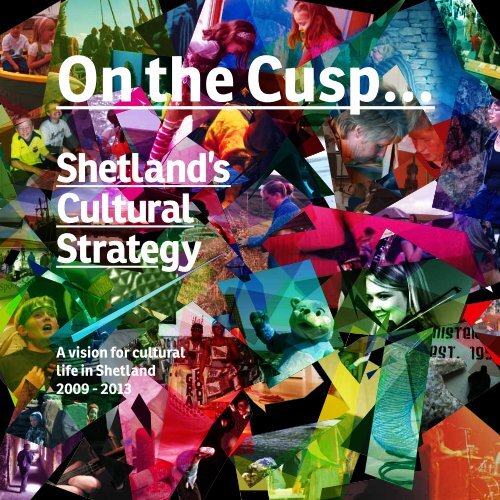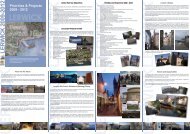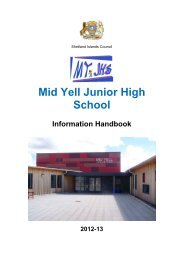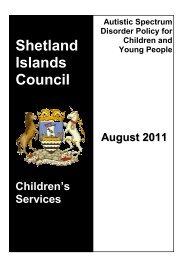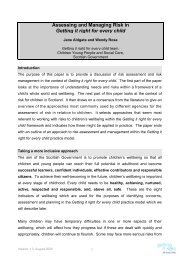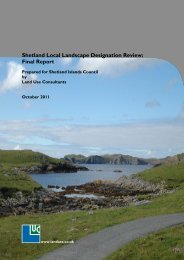Shetland's Cultural Strate gy - Shetland Islands Council
Shetland's Cultural Strate gy - Shetland Islands Council
Shetland's Cultural Strate gy - Shetland Islands Council
You also want an ePaper? Increase the reach of your titles
YUMPU automatically turns print PDFs into web optimized ePapers that Google loves.
On the Cusp...<br />
<strong>Shetland</strong>’s<br />
<strong>Cultural</strong><br />
<strong>Strate</strong> <strong>gy</strong><br />
A vision for cultural<br />
life in <strong>Shetland</strong><br />
2009 - 2013
A vision for cultural life in <strong>Shetland</strong> 2009 - 2013 01.<br />
<strong>Shetland</strong>’s culture is at the heart of our lives. We are very proud of<br />
our cultural heritage; we keep our traditions alive and learn from<br />
the past, but we are also a forward looking community and have<br />
a continual thirst for new cultural experiences and influences.<br />
The <strong>Strate</strong><strong>gy</strong> recognises <strong>Shetland</strong>’s extraordinarily rich heritage,<br />
traditions and creativity and its unspoilt natural environment.<br />
This strate<strong>gy</strong> has been prepared by a number of organisations in <strong>Shetland</strong><br />
which, working in partnership and individually, will fulfill its aims and<br />
objectives. It seeks to offer a shared view of the way in which <strong>Shetland</strong>’s<br />
citizens would like life in the islands to develop. The <strong>Strate</strong><strong>gy</strong> sets out<br />
objectives for developing cultural facilities, services and activities for<br />
the benefit of the <strong>Shetland</strong> community. It recognises that there is a vital<br />
contribution to be made by public agencies and private enterprise, but<br />
that the essence of <strong>Shetland</strong> cultural life flows from local communities<br />
and individuals. This strate<strong>gy</strong> is therefore for everyone in <strong>Shetland</strong>.<br />
As the Chairman of the Community Planning Board, I am confident<br />
that this <strong>Strate</strong><strong>gy</strong>, and the Action Plan flowing from it, will help<br />
us work together to achieve the goals in our Community Plan - a<br />
prosperous economy; a society which is vibrant, healthy, safe and in<br />
which everyone can take part; an environment which is conserved and<br />
enhanced; and a cultural identity which is celebrated and promoted.<br />
This is a crucial time for <strong>Shetland</strong>. Our islands’ culture is at last<br />
being recognised for the resource it is and some very positive<br />
developments are underway or contemplated. We really are<br />
‘on the cusp’; I believe that we have the potential to be the most<br />
exciting creative and cultural island community in the world.<br />
I wish those involved in leading on cultural activity well. I look<br />
forward to seeing continuing progress throughout <strong>Shetland</strong>.<br />
Sandy Cluness<br />
Chair, Community Planning Board
02. On the Cusp... <strong>Shetland</strong>’s <strong>Cultural</strong> <strong>Strate</strong><strong>gy</strong><br />
Contents<br />
Foreword 03.<br />
Background 05.<br />
Vision, Themes and Objectives 08.<br />
Monitoring and Review 16.<br />
Communication 16.<br />
Generations<br />
Da filskit scallywags dat dey ir<br />
da young eens, wir ain bairns<br />
dem makkin aw yun upsteer an halliracket.<br />
Some bricht new moarnin, no sae lang fae noo<br />
some lang lippened day i da future<br />
dey’ll grip da tiller oot o wir haands<br />
an sail dir solo coorse, shaeste dir ain fate.<br />
James Sinclair
A vision for cultural life in <strong>Shetland</strong> 2009 - 2013 03.<br />
Foreword<br />
By Rick Nickerson, Spokesperson<br />
- Culture & Recreation<br />
& Hazel Sutherland, Executive Director<br />
of Education and Social Care<br />
In promoting this second <strong>Shetland</strong> <strong>Cultural</strong> <strong>Strate</strong><strong>gy</strong>,<br />
we recognise that the term ‘culture’ can mean<br />
different things to different people. However, for<br />
the purposes of this <strong>Strate</strong><strong>gy</strong>, it includes visual<br />
arts, music, song, theatre, dance, film, digital<br />
media, prose, poetry, food and the built and natural<br />
heritage. Sport and physical recreation, which<br />
were included in the first <strong>Cultural</strong> <strong>Strate</strong><strong>gy</strong>, will<br />
henceforth be covered by a separate strate<strong>gy</strong>.<br />
<strong>Shetland</strong> is blessed with a rich and diverse culture; it<br />
has Pictish, Norse and Scottish roots, but there were<br />
other important historical connections, particularly<br />
with Germany and the Netherlands. <strong>Shetland</strong>’s<br />
geographical remoteness has helped preserve<br />
customs, traditions and artifacts; but that remoteness<br />
has been tempered by contacts with many peoples,<br />
not only around the North Atlantic and North Sea but<br />
also much farther afield. Over centuries, this northern<br />
crossroads has seen thousands of travellers come<br />
and go for every conceivable purpose: fishing, trade,<br />
kinship, war and oil are just the more obvious ones.<br />
<strong>Shetland</strong>ers are also conspicuously well-travelled<br />
themselves; thanks in part to the Press Gang, they<br />
were prominent in the Royal Navy but also sailed the<br />
world on merchant ships or whalers. Today’s young<br />
<strong>Shetland</strong>ers forge links with their contemporaries<br />
in many countries, from Japan to the USA and the<br />
Czech Republic to South Africa or southern India,<br />
particularly through the Global Classroom.<br />
The islands’ fishing, knitting and agricultural traditions<br />
are essential foundations for the islands’ culture and<br />
have impacted on the cultural heritage of <strong>Shetland</strong><br />
in terms of language, dialect and traditional skills.<br />
However, <strong>Shetland</strong>ers have also responded to many<br />
new influences. Today, island life is enriched by the<br />
participation of people from many different parts of<br />
the world. The result is a culture that is distinctive,<br />
strong and dynamic. It is an enviable legacy.<br />
Culture is central to any community’s quality of life<br />
and wellbeing; it largely defines the identity of a<br />
place and its people and it promotes personal growth<br />
and community cohesion. A vibrant and distinctive<br />
culture is also a hugely important economic asset.<br />
Investment in culture, which can take many forms,<br />
may therefore be expected to produce many different<br />
benefits. In <strong>Shetland</strong>, physical infrastructure provided<br />
over the last 30 years has included many new or<br />
improved community halls, the Bonhoga Gallery,<br />
improved interpretation at many sites, the restoration<br />
of many significant buildings, archaeological<br />
excavations, a library and, last but most certainly not<br />
least, a new Museum and Archives that is a stunning<br />
achievement in both conception and execution.<br />
However, there have also been many other kinds<br />
of investment, not only in cash but also in time,<br />
imagination and ener<strong>gy</strong>. <strong>Shetland</strong>’s education system<br />
helps nurture traditional skills and knowledge but<br />
also provides a springboard for creative talent in every<br />
sphere; its record in the encouragement of local music<br />
and musicians is exemplary. Local voluntary groups<br />
have undertaken all kinds of cultural projects, from<br />
dialect recording and work in schools through the<br />
operation of local heritage centres to the promotion<br />
of the work of <strong>Shetland</strong>’s contemporary artists.<br />
There has been important private investment too, for<br />
example in recording facilities and in gallery space.
04. On the Cusp... <strong>Shetland</strong>’s <strong>Cultural</strong> <strong>Strate</strong><strong>gy</strong><br />
Several events have become established,<br />
including the <strong>Shetland</strong> Folk Festival, the Fiddle<br />
and Accordion Festival, Wordplay, Screenplay<br />
and the Johnsmas Foy, incorporating Flavour<br />
of <strong>Shetland</strong>. New fire festivals have appeared<br />
around the islands alongside the Lerwick<br />
Up Helly Aa. These events are recognised world wide.<br />
There can be no doubt that these developments<br />
have been a source of pride and confidence<br />
in the community, that they have made life in<br />
the islands so much more rewarding and that<br />
they have significantly strengthened <strong>Shetland</strong>’s<br />
reputation. In all these respects, they have improved<br />
the prospects for economic development, most<br />
obviously through tourism but in other ways too.<br />
To the extent that the <strong>Council</strong> supports these<br />
facilities, it discharges its statutory duty to ‘ensure<br />
that there is adequate provision of facilities for<br />
the inhabitants of their area for recreational,<br />
sporting, cultural and social activities’.<br />
This <strong>Strate</strong><strong>gy</strong> brings together a partnership of agencies<br />
and communities with the aim of ensuring that our<br />
cultural life continues to thrive and develop. Each of<br />
these partners will, where appropriate, prepare or<br />
revise their own strategies, but we have included what<br />
we regard as the ‘flagship’ projects and opportunities<br />
in the Action Plan that forms part of this <strong>Strate</strong><strong>gy</strong>.<br />
There are opportunities for everyone in <strong>Shetland</strong> to<br />
participate at whatever level they wish. We want them<br />
to have the chance to be challenged, excited, inspired<br />
and educated and, above all, to fulfill their potential.<br />
Local Government and Planning<br />
(Scotland) Act 1982, Section 14.<br />
The foundation for further development is sound and<br />
we must aspire to make progress on all fronts, for<br />
culture is at the heart of any new <strong>Shetland</strong>, vital for<br />
future health, social strength and economic prosperity.<br />
It has been estimated that <strong>Shetland</strong>’s creative<br />
industries contribute around £25m to the economy.<br />
Within the lifetime of this <strong>Strate</strong><strong>gy</strong>, <strong>Shetland</strong>ers can<br />
look forward to the provision of Mareel, one of the<br />
outcomes of the first <strong>Cultural</strong> <strong>Strate</strong><strong>gy</strong>. A first class<br />
cinema, music venue and educational facility, it will<br />
not only bring a real cinema experience and celebrate<br />
one of <strong>Shetland</strong>’s most robust resources, namely the<br />
islands’ musical heritage; it will also demonstrate<br />
confidence in the creative industries in general, a<br />
sector which is seen as having real growth potential.<br />
We hope that other important projects will also<br />
come to fruition over the period of the <strong>Strate</strong><strong>gy</strong>.
A vision for cultural life in <strong>Shetland</strong> 2009 - 2013 05.<br />
Background<br />
The <strong>Shetland</strong> <strong>Cultural</strong> <strong>Strate</strong><strong>gy</strong> is a strate<strong>gy</strong> for all<br />
of <strong>Shetland</strong>, for all who live here and all who visit<br />
us, and it could not have been prepared without the<br />
assistance of many individuals and organisations<br />
that contributed their knowledge, opinions<br />
and recommendations during 2008. A Steering<br />
Group, convened by <strong>Shetland</strong> <strong>Islands</strong> <strong>Council</strong>,<br />
has guided the development of the <strong>Strate</strong><strong>gy</strong>.<br />
The <strong>Strate</strong><strong>gy</strong> is important because it covers so<br />
many areas of people’s lives. It touches on all the<br />
things we do and enjoy: the things in which we<br />
believe or take pride and the things we want to<br />
achieve, whether as individuals or communities.<br />
It must conserve our inheritance while capturing<br />
<strong>Shetland</strong>’s potential for the future. It needs<br />
to reach into our outlying communities.<br />
In developing strategies of this kind and putting them<br />
into effect, we must also bear in mind the interests of<br />
people beyond the islands, because our cultural life<br />
is one of the things that attract people to visit us or to<br />
join us as new <strong>Shetland</strong>ers. <strong>Shetland</strong>, as a whole or<br />
in its parts, has been recognised by growing numbers<br />
of writers and broadcasters. We must recognise the<br />
islands’ value in their terms as well as in ours; it will<br />
be important not to take our strengths for granted.<br />
When we refer to <strong>Shetland</strong>’s potential, we do not<br />
only mean the cultural value of our heritage and<br />
contemporary practice or the sheer skill that may<br />
be displayed by our artists, musicians, cooks or<br />
craftspeople, though developing these for their<br />
own sake is essential in itself. We also mean the<br />
economic potential of <strong>Shetland</strong>’s culture. Because<br />
it is distinctive and authentic, it not only attracts<br />
visitors but is partly responsible for building the<br />
kind of reputation that can inspire people to seek out<br />
the best of <strong>Shetland</strong> products, wherever they live. A<br />
cherished, vibrant culture is an indispensable tool in<br />
building a healthy economy and healthy community.<br />
Culture plays an important role in supporting<br />
individual and community wellbeing. At the heart<br />
of <strong>Shetland</strong> becoming ‘healthier’ is effort to help the<br />
population stay well. Participation and attendance at<br />
cultural events reduces isolation, brings communities<br />
together and in doing so provides opportunities to<br />
maintain social networks that are vital to mental<br />
wellbeing. Further, the very act of coming together<br />
provides ‘a sense of place’ and a range of collective<br />
experiences, which strengthen communities and<br />
increase community confidence and ability to respond<br />
to change. However it doesn’t stop there. There are<br />
many known physical health benefits associated<br />
from attending and engaging in cultural activity.
06. On the Cusp... <strong>Shetland</strong>’s <strong>Cultural</strong> <strong>Strate</strong><strong>gy</strong><br />
The <strong>Cultural</strong> <strong>Strate</strong><strong>gy</strong> builds on existing cultural<br />
strengths. It is intended to influence policies, activities<br />
and investment across all aspects of <strong>Shetland</strong> life.<br />
By exposing the possibilities and options, it should<br />
assist communities and politicians when they need<br />
to decide between competing priorities. It seeks to<br />
identify important cultural development opportunities<br />
and suggest means by which they can be seized.<br />
By explaining how individual cultural developments<br />
fit into an overall framework that has the support<br />
of the partners and the community, the <strong>Strate</strong><strong>gy</strong><br />
should provide evidence to local and external<br />
funding bodies that new projects are being brought<br />
forward in a considered and coherent manner.<br />
In general terms, the principles behind this second<br />
<strong>Shetland</strong> <strong>Cultural</strong> <strong>Strate</strong><strong>gy</strong> echo national policy<br />
and ‘Culture Delivers’ (Scottish Government).<br />
The <strong>Shetland</strong> partners wish to endorse the<br />
need for equality of opportunity and the<br />
participation of all sections of the community.<br />
The development of cultural opportunities in<br />
<strong>Shetland</strong> should satisfactorily balance economic,<br />
environmental and social considerations; in other<br />
words, the process should be sustainable.<br />
The <strong>Shetland</strong> <strong>Cultural</strong> <strong>Strate</strong><strong>gy</strong> is a means of enriching<br />
life in <strong>Shetland</strong>. It is expected to have a five-year life,<br />
but it will be reviewed at least once during that period.<br />
These priorities include:<br />
• Improving access for all, removing barriers<br />
(including lack of transport) where possible and<br />
promoting the use of information technolo<strong>gy</strong>.<br />
• Improving recognition of the<br />
value of volunteers.<br />
• Making more and better use of<br />
the available facilities.<br />
• Continue to support in development and<br />
maintenance of community facilities such as<br />
public halls and help groups access funding.<br />
• Encouraging new facilities where they will<br />
strengthen what <strong>Shetland</strong> has to offer.<br />
• Increasing the range of cultural activities to<br />
meet the needs of new user groups and visitors.<br />
• Developing and improving promotion of<br />
the unique <strong>Shetland</strong> natural environment,<br />
archaeolo<strong>gy</strong> and cultural traditions.<br />
• Ensuring that cultural activities<br />
are available from pre-school age<br />
throughout school years and beyond.<br />
• Maintaining and developing inclusive formal<br />
and informal arts education programmes.<br />
• Using cultural resources to improve<br />
health and well-being.<br />
• Exploring new partnerships to support<br />
fresh approaches to creative industries,<br />
tourism and regeneration.<br />
• Recognising the importance of diverse<br />
cultural provision in retaining young<br />
people in <strong>Shetland</strong> and attracting new<br />
people to settle in the islands.<br />
• Maximising financial support and<br />
sponsorship so that more can be<br />
achieved within available resources.
A vision for cultural life in <strong>Shetland</strong> 2009 - 2013 07.<br />
This <strong>Strate</strong><strong>gy</strong> seeks to:<br />
• Unite the community and service<br />
providers in partnership.<br />
• Support and involve all individuals and<br />
communities wishing to engage in cultural<br />
activity, wherever they are in <strong>Shetland</strong>.<br />
• Improve <strong>Shetland</strong>’s economic prospects.<br />
• Preserve and conserve <strong>Shetland</strong>’s<br />
heritage, culture and environment.<br />
• Nurture new <strong>Shetland</strong> talent and provide<br />
an environment in which creative skills can<br />
flourish both in and outside <strong>Shetland</strong>.<br />
• Strengthen confidence, pride<br />
and a sense of place.
08. On the Cusp... <strong>Shetland</strong>’s <strong>Cultural</strong> <strong>Strate</strong><strong>gy</strong><br />
Vision, Themes and Objectives<br />
A vision for cultural life in <strong>Shetland</strong>.<br />
We seek to ensure that <strong>Shetland</strong>’s cultural assets<br />
are conserved, developed and supported in order<br />
to allow everyone to reach his or her potential,<br />
strengthen community identity, pride and confidence<br />
and secure prosperity for the benefit of present<br />
and future generations. We intend that <strong>Shetland</strong>’s<br />
cultural assets will be recognised as among the<br />
richest and most diverse to be found anywhere.<br />
We want <strong>Shetland</strong> to be the most exciting creative<br />
and cultural island community in the world.<br />
Themes<br />
1. Access, participation and potential<br />
Encourage active and participative lifestyles,<br />
equality of opportunity, personal growth and<br />
community development through increasing<br />
access to, and participation in, the broadest<br />
range of cultural activities throughout<br />
<strong>Shetland</strong>, particularly for people who may<br />
be excluded or marginalised at present.<br />
2. Creativity and heritage<br />
Celebrate and promote the islands’ creativity,<br />
multinational culture, distinctive heritage,<br />
dialect and environment, and develop and<br />
promote them within <strong>Shetland</strong> and to the wider<br />
world and recognise the value of collaboration<br />
and partnership in and outwith <strong>Shetland</strong>.<br />
3. Learning<br />
Recognise the value of creative and cultural skills<br />
as a source of self-fulfillment and a foundation<br />
for community learning and identity, ensuring<br />
that the broadest practicable range of related<br />
educational opportunities are available both<br />
informal/formal for a range of ages (including<br />
cross generational) and backgrounds.<br />
4. Culture and the Economy<br />
Ensure that the connections between culture<br />
and economic development are explored and<br />
understood and that investment in cultural assets<br />
and creative activities is actively pursued as a means<br />
to increasing prosperity. <strong>Shetland</strong> has a chance to<br />
exploit its unique place in a connected digital world<br />
that makes us more accessible than ever before.<br />
5. Health and Wellbeing<br />
Recognise the impact that participation in<br />
cultural activities and cultural development<br />
has on the health and wellbeing of individuals<br />
and communities. Encourage and promote<br />
programmes that improve health and wellbeing<br />
through culture and cultural activities.<br />
Aims<br />
Within each of these five themes, it is possible to<br />
set out three or four main aims linked to aspects of<br />
<strong>Shetland</strong> life and culture and identify methods of<br />
achieving them. These aims may be pursued by the<br />
community in general or, by the <strong>Council</strong>, <strong>Shetland</strong><br />
Arts, <strong>Shetland</strong> Amenity Trust or other organisations,<br />
including the voluntary and private sectors.
A vision for cultural life in <strong>Shetland</strong> 2009 - 2013 09.<br />
Theme 1<br />
Access, Participation<br />
and Potential<br />
1.2.3<br />
1.2.4<br />
Develop a <strong>Shetland</strong> Heritage Association<br />
Action Plan in consultation with<br />
community history groups.<br />
Develop and support a network of<br />
artist led or facilitated groups.<br />
Encourage active lifestyles and paticipation in a<br />
broad range of cultural activities for everyone.<br />
Aim 1.1<br />
Support the contribution of cultural life to the<br />
vitality and economic prosperity of <strong>Shetland</strong>.<br />
Methods<br />
1.1.1<br />
1.1.2<br />
Promote cultural initiatives in order<br />
to build community confidence<br />
and increase the sustainability of<br />
communities throughout <strong>Shetland</strong>.<br />
Improve access to, and participation<br />
in, a diverse range of cultural activities<br />
for all residents and visitors, especially<br />
those in outlying communities or<br />
at risk of social exclusion.<br />
Aim 1.2<br />
Maintain and develop the services and<br />
facilities necessary for the vitality and<br />
prosperity of <strong>Shetland</strong>’s cultural life.<br />
Methods<br />
1.2.1<br />
1.2.2<br />
Support people who volunteer and<br />
recognise those who work in the cultural<br />
sectors throughout <strong>Shetland</strong>; promote their<br />
value in terms of the cultural life of the<br />
islands and provide the training they need<br />
to enable them to contribute effectively.<br />
Promote the intrinsic value of<br />
cultural facilities, activities and<br />
services throughout <strong>Shetland</strong>.<br />
Aim 1.3<br />
Promote activities and facilities that<br />
encourage individuals of all abilities,<br />
especially young people, to pursue a lifestyle<br />
that supports their development.<br />
Methods<br />
1.3.1<br />
1.3.2<br />
1.3.3<br />
1.3.4<br />
Ensure that diverse cultural activities and<br />
facilities are provided throughout <strong>Shetland</strong><br />
to meet the needs of local communities.<br />
Support strategies and activities that<br />
encourage individuals to develop healthy<br />
lifestyles and participate (and achieve<br />
their potential) in cultural activities.<br />
Promote access to and understanding<br />
of <strong>Shetland</strong>’s natural environment.<br />
Ensure that modern information<br />
communications are available for<br />
people to be creative in digital media.<br />
Aim 1.4<br />
Support participation in the cultural life<br />
of the islands by ensuring that there are<br />
accessible transport services to and from<br />
<strong>Shetland</strong>, and within <strong>Shetland</strong>.<br />
Method<br />
1.4.1<br />
Seek to ensure that external air and ferry<br />
services are convenient and affordable<br />
and that internal transport services<br />
offer opportunities to participate in<br />
cultural events for everyone, whether<br />
or not they have personal transport.
10. On the Cusp... <strong>Shetland</strong>’s <strong>Cultural</strong> <strong>Strate</strong><strong>gy</strong><br />
Theme 2<br />
Creativity and Heritage<br />
Celebrate, promote and invest in the islands’<br />
distinctive creativity, diverse culture,<br />
heritage and environment and promote these<br />
within <strong>Shetland</strong> and to the wider world.<br />
Aim 2.1<br />
Celebrate and build on the diversity and<br />
excellence of artistic and creative activity<br />
that is characteristic of <strong>Shetland</strong>.<br />
Methods<br />
2.1.1<br />
2.1.2<br />
2.1.3<br />
2.1.4<br />
2.1.5<br />
2.1.6<br />
Provide strategic support for cultural and<br />
creative infrastructure including training<br />
and career development opportunities.<br />
Support and develop a programme<br />
of bringing cultural activities and<br />
artists into <strong>Shetland</strong> for the benefit<br />
of residents of <strong>Shetland</strong>.<br />
Maintain and develop arts education in<br />
schools, further and higher education;<br />
develop facilities which enable young<br />
artists to perform and develop their careers.<br />
Support individual and collective<br />
expression in traditional and new<br />
forms of creative activity.<br />
Develop, promote and support<br />
<strong>Shetland</strong> talent outwith <strong>Shetland</strong>.<br />
Promote cultural exchange between<br />
<strong>Shetland</strong> and other places recognising<br />
both our traditional links and<br />
the potential of new ones.<br />
Aim 2.2<br />
Sustain and promote <strong>Shetland</strong>’s dialects and<br />
place names within the <strong>Islands</strong> and beyond.<br />
Methods<br />
2.2.1<br />
2.2.2<br />
2.2.3<br />
Support and promote the use and culture<br />
of, and develop interest in, <strong>Shetland</strong>’s<br />
dialects, place names and literature.<br />
Continue to encourage the use of <strong>Shetland</strong><br />
dialects in schools and informal settings.<br />
Support organisations that seek<br />
to record and promote dialect.<br />
Aim 2.3<br />
Maintain, develop and promote the rich cultural<br />
and natural heritage, arts and crafts, architecture,<br />
built environment and archaeolo<strong>gy</strong> of <strong>Shetland</strong>.<br />
Methods<br />
2.3.1<br />
2.3.2<br />
2.3.3<br />
2.3.4<br />
Maintain, develop and promote <strong>Shetland</strong>’s<br />
museums, galleries, libraries, archives,<br />
recognising them as centres of excellence.<br />
Support the recording of<br />
<strong>Shetland</strong>’s cultural heritage.<br />
Ensure the long-term preservation of<br />
<strong>Shetland</strong> artefact, archive, heritage and<br />
library collections within the islands<br />
including the repatriation of key artefacts<br />
and digitising of library material.<br />
Continue to manage <strong>Shetland</strong>’s<br />
built environment, including the<br />
archaeological heritage, in ways that<br />
respect its outstanding quality.
A vision for cultural life in <strong>Shetland</strong> 2009 - 2013 11.<br />
2.3.5<br />
2.3.6<br />
2.3.7<br />
Methods<br />
2.4.1<br />
2.4.2<br />
2.4.3<br />
Promote, interpret and facilitate access<br />
to <strong>Shetland</strong>’s built environment and its<br />
archeological and cultural heritage.<br />
Encourage traditional skills such as<br />
drystane dyking, peat casting, boat building,<br />
lime work and hand knitted fine lace.<br />
Encourage appropriate habitat<br />
management in order to secure<br />
and strengthen biodiversity.<br />
Aim 2.4<br />
Safeguard, promote and ensure access to<br />
the natural environment of <strong>Shetland</strong> and its<br />
outstanding landscape, flora and fauna.<br />
Recognise that <strong>Shetland</strong>’s exceptional<br />
landscapes and seascapes are among<br />
our strongest assets and ensure that<br />
development within them is carefully<br />
considered and appropriate.<br />
Support efforts to have the special qualities<br />
of <strong>Shetland</strong>’s natural environment<br />
recognised and promoted, for example<br />
through Geopark designation.<br />
Safeguard, promote, and ensure appropriate<br />
access to, <strong>Shetland</strong>’s wildlife, sea life<br />
and high quality natural environment.<br />
Aim 2.5<br />
Encourage and promote creative industries.<br />
Methods<br />
2.5.1<br />
2.5.2<br />
2.5.3<br />
2.5.4<br />
2.5.5<br />
2.5.6<br />
2.3.7<br />
Support sustainable creative industries<br />
and clusters of related industries in<br />
<strong>Shetland</strong>, recognising that they offer<br />
potential for employment and the<br />
generation of activity in rural areas<br />
including the new technologies available.<br />
Ensure that percent for art is<br />
incorporated where appropriate in new<br />
development proposals and encouraged<br />
as part of refurbishment projects.<br />
Recognise the value of architecture<br />
and planning in creating surroundings<br />
that are distinctive, memorable,<br />
rewarding and stimulating.<br />
Develop traditional and contemporary<br />
craft industries and use their<br />
products to strengthen <strong>Shetland</strong>’s<br />
identity throughout the world.<br />
Seek to revitalise craft industries where<br />
they are at risk or in decline, promoting<br />
the teaching of traditional skills and<br />
exploring new market opportunities.<br />
Encourage the use of <strong>Shetland</strong><br />
locations in film and television<br />
productions and the use of <strong>Shetland</strong><br />
stories and themes in screenplays.<br />
Lobby for the highest possible levels<br />
of broadband to encourage creative<br />
IT businesses to thrive in <strong>Shetland</strong>.
12. On the Cusp... <strong>Shetland</strong>’s <strong>Cultural</strong> <strong>Strate</strong><strong>gy</strong><br />
Theme 3<br />
Learning<br />
Theme 4<br />
Culture and the Economy<br />
Ensure that, whatever their age,<br />
background or interests, people have the<br />
opportunity to learn about and participate<br />
in <strong>Shetland</strong>’s culture and heritage.<br />
Aim 3.1<br />
Support the contribution of cultural activities<br />
to school education and to the lifelong<br />
learning process for the wider community.<br />
Methods<br />
3.1.1<br />
3.1.2<br />
Offer diverse cultural and multicultural<br />
teaching and activities within<br />
schools, further and higher education<br />
establishments and informal settings.<br />
Promote the cultural benefits of<br />
learning, whether formal or informal,<br />
for individuals and communities.<br />
Ensure that the value of cultural activity in securing<br />
a prosperous future is recognised and captured.<br />
Aim 4.1<br />
Recognise the contribution made by cultural<br />
heritage and activity to sustainable economic<br />
development and support appropriate projects.<br />
Methods<br />
4.1.1<br />
4.1.2<br />
4.1.3<br />
Support development based on cultural<br />
heritage, cultural activity and creative<br />
enterprise that is appropriate in<br />
environmental, economic and social terms.<br />
Place cultural assets at the heart of the<br />
marketing and promotion of <strong>Shetland</strong><br />
and support activity by <strong>Shetland</strong> talent<br />
outwith the islands where doing so<br />
will help to advance these aims.<br />
Consider opportunities for the<br />
more effective marketing, in and<br />
beyond <strong>Shetland</strong>, of products<br />
related to <strong>Shetland</strong> culture.
A vision for cultural life in <strong>Shetland</strong> 2009 - 2013 13.<br />
Aim 4.2<br />
Recognise that the principal foundations<br />
for developing tourism are <strong>Shetland</strong>’s rich<br />
and diverse cultural life and outstanding<br />
built and natural heritage.<br />
Methods<br />
4.2.1<br />
4.2.2<br />
Work with all relevant agencies to<br />
ensure that cultural and heritage assets<br />
are conserved, that appropriate new<br />
facilities are developed and that the<br />
quality of related services provided<br />
to visitors is as good as it can be.<br />
Promote, by the most effective means, the<br />
diversity and quality of available cultural<br />
and heritage assets, facilities and activities.<br />
Aim 4.3<br />
Promote <strong>Shetland</strong>’s cultural life and activities in<br />
order to contribute to the retention and growth<br />
of the population of the islands, especially in<br />
fragile areas and outlying communities.<br />
Methods<br />
4.3.1<br />
4.3.2<br />
4.3.3<br />
4.3.4<br />
4.3.5<br />
Support in culture to provide facilities,<br />
activities and employment opportunities<br />
which attract individuals and<br />
organisations to locate in <strong>Shetland</strong>.<br />
Recognise that, in attracting people<br />
to live in <strong>Shetland</strong>, the cultural<br />
heritage and the presence of a vibrant<br />
creative community are both vital.<br />
Recognise the important role in building<br />
confidence and strengthening reputation<br />
of events such as Up Helly Aa, the<br />
<strong>Shetland</strong> Folk Festival, the Johnsmas<br />
Foy, Fiddle Frenzy, the <strong>Shetland</strong> Food<br />
Festival, the Fiddle and Accordion<br />
Festival, WordPlay and ScreenPlay.<br />
Support volunteering, recognising that<br />
it makes a vital contribution to creative<br />
activities; ensure that training is provided<br />
to deal with new challenges; and support<br />
efforts to ensure that the legislative<br />
framework within which volunteers<br />
work is realistic and appropriate.<br />
Work with the media to promote and report<br />
cultural issues, activities and achievements.
14. On the Cusp... <strong>Shetland</strong>’s <strong>Cultural</strong> <strong>Strate</strong><strong>gy</strong><br />
Theme 5<br />
Health and Well-being<br />
Ensure that the reciprocal relationship between<br />
culture and health is considered in all areas<br />
of cultural promotion and development.<br />
Aim 5.1<br />
Recognise and support cultural activities for<br />
their value in promoting health and well-being.<br />
Methods<br />
5.1.1<br />
5.1.2<br />
Build the health and well-being<br />
benefits of cultural activities into<br />
promotional activities such as mental<br />
health awareness campaigns.<br />
Build the health and well-being<br />
benefits of cultural activities into all<br />
relevant strategies and action plans.<br />
Aim 5.2<br />
Where appropriate, carry out health impact<br />
assessments on cultural developments.<br />
Methods<br />
5.2.1<br />
5.2.2<br />
5.2.3<br />
Educate multi-agency staff involved in<br />
cultural development on the benefits<br />
of health impact assessments.<br />
Promote services provided by<br />
Health Improvement in carrying<br />
out health impact assessments.<br />
Look into the development of training<br />
for multi-agency staff on carrying<br />
out health impact assessments.<br />
Aim 5.3<br />
Support and promote projects that<br />
complement cultural activities in the<br />
promotion of health and well-being.<br />
Recognise aspects of culture that may<br />
be potentially detrimental to health and<br />
well-being and develop and implement<br />
strategies and actions to address these.<br />
Method<br />
5.3.1<br />
Support and promote the Drink Better<br />
Programme, obesity programmes, sexual<br />
health and smoking cessation programmes<br />
and look to extend prescribing programmes<br />
to include arts activity and ‘green <strong>gy</strong>ms’<br />
in heritage and cultural settings.
A vision for cultural life in <strong>Shetland</strong> 2009 - 2013 15.<br />
Action Plan<br />
This <strong>Cultural</strong> <strong>Strate</strong><strong>gy</strong> cannot encompass every<br />
project or initiative now contemplated, far less<br />
anticipate those that may emerge over its lifetime.<br />
However, certain actions are fundamental; they can<br />
be seen as foundations that will strongly support<br />
cultural activity, raise confidence and enhance<br />
<strong>Shetland</strong>’s reputation as a place that is creative,<br />
clever and connected. They fall into three categories:<br />
• Physical Resources<br />
• Human Resources<br />
• Events<br />
Physical Resources<br />
Various initiatives involving work on the<br />
ground are seen as essential catalysts;<br />
in alphabetical order, they are:<br />
• Garrison Theatre Refurbishment<br />
• Lerwick Library Refurbishment<br />
• Mareel<br />
• Maywick to Scalloway Fibre Optic Link<br />
• Old Scatness<br />
• <strong>Shetland</strong> Textile Museum<br />
• Sumburgh Head<br />
• Viking Unst<br />
• Several initiatives involving work on the<br />
ground are seen as essential catalysts and<br />
they are, ongoing support for community<br />
and development for existing and new<br />
facilities, e.g. schools, community halls,<br />
community museums, for example Tingwall<br />
Agricultural Museum and Scalloway Museum.<br />
Human Resources<br />
Progress depends on:<br />
• Identifying talented people and offering<br />
them appropriate training and support.<br />
• Attracting creative people to<br />
live and work in <strong>Shetland</strong>.<br />
• Encouraging the widest possible<br />
participation by the people of <strong>Shetland</strong><br />
in cultural and creative activity.<br />
Events<br />
Events offer opportunities to discover and<br />
highlight talent. They can also contribute<br />
strongly to efforts to raise confidence and<br />
develop reputation. The key action required is the<br />
development of an Events <strong>Strate</strong><strong>gy</strong> that will:<br />
• Define the ways in which events<br />
may contribute to cultural and<br />
economic development.<br />
• Establish criteria to assist in assessing<br />
the value of existing and proposed new<br />
events and determining the level of<br />
support that they should receive.<br />
• Indicate how benefits to <strong>Shetland</strong><br />
can best be realised from one-off or<br />
irregular events to which commitments<br />
have been made, including:<br />
The Year of Architecture<br />
- Power of Place 2009/10<br />
Hamefarin’ - 2010<br />
Mirrie Dancers - 2009/10<br />
Tall Ships Races - 2011<br />
<strong>Cultural</strong> Olympiad - London 2012<br />
A Year of Island Cultures - 2011<br />
It is proposed that an outline Events <strong>Strate</strong><strong>gy</strong><br />
will be developed by Spring 2010.
16. On the Cusp... <strong>Shetland</strong>’s <strong>Cultural</strong> <strong>Strate</strong><strong>gy</strong><br />
Monitoring and Review<br />
Communication<br />
Monitoring<br />
This <strong>Cultural</strong> <strong>Strate</strong><strong>gy</strong> provides a framework for<br />
policy and the development of action plans by many<br />
different organisations, most of which have their<br />
own more detailed strategies. This <strong>Strate</strong><strong>gy</strong> and<br />
the accompanying Action Plan indicate practical<br />
methods of achieving goals. Initially the <strong>Council</strong>, the<br />
Charitable Trusts, and the many potential partner<br />
organisations should revise their departmental and<br />
corporate strategies in order to ensure that, as far as<br />
practicable, they reflect the proposals outlined here.<br />
This strate<strong>gy</strong> is for everyone in <strong>Shetland</strong>. It is<br />
important that it is widely available and relevant.<br />
The <strong>Strate</strong><strong>gy</strong> is available in print format and on the<br />
<strong>Council</strong>’s web site - (www.shetland.gov.uk).<br />
Review<br />
This second <strong>Shetland</strong> <strong>Cultural</strong> <strong>Strate</strong><strong>gy</strong>, launched in<br />
November 2009, builds on the work done between<br />
2004 and 2008. It is intended to stimulate progress<br />
and change rather than being seen as something<br />
static, for that is how it can remain relevant to the<br />
<strong>Shetland</strong> community. This <strong>Strate</strong><strong>gy</strong> covers a five year<br />
period from 2009 to 2013, and within the <strong>Council</strong><br />
it is the responsibility of the Executive Director,<br />
Education and Social Care. It is recommended that<br />
the <strong>Strate</strong><strong>gy</strong> be formally reviewed at least once<br />
during its lifetime by the <strong>Cultural</strong> <strong>Strate</strong><strong>gy</strong> Planning<br />
Group. The reviews should allow account to be<br />
taken of changing circumstances and new ideas.<br />
A summary review and progress report should<br />
be prepared annually and distributed widely;<br />
revisions should appear on the section of the<br />
<strong>Council</strong>’s web site devoted to the <strong>Cultural</strong> <strong>Strate</strong><strong>gy</strong>.
<strong>Cultural</strong> <strong>Strate</strong><strong>gy</strong> Planning Group Members<br />
Rick Nickerson Chair of Group & Spokesperson for Culture and Recreation<br />
Andy Steven Visit <strong>Shetland</strong><br />
Philip Ashley Smith SIC Sport and Leisure Service<br />
Sue Beer Voluntary Action <strong>Shetland</strong><br />
Suzanne Shearer SIC Infrastructure Service<br />
Linda Coutts SIC Development Service<br />
Bill Crook SIC Community Work<br />
Silvija Crook SIC Schools Service<br />
Gwilym Gibbons <strong>Shetland</strong> Arts Development Agency<br />
Florence Grains SIC Elected Member<br />
Alastair Hamilton SIC Development Service<br />
Noelle Henderson SIC Schools Service<br />
Kathy Hubbard <strong>Shetland</strong> Arts Development Agency<br />
Catherine Hughson Voluntary Action <strong>Shetland</strong><br />
Douglas Irvine SIC Development Service<br />
Jane Thomas Crofters Commission<br />
Jonathan Swale Scottish National Heritage<br />
Hazel Sutherland SIC Executive Director<br />
Mary Blance <strong>Shetland</strong> ForWirds<br />
Caroline Miller SIC Elected Member<br />
Jonathan Molloy SIC Infrastructure Service<br />
Jimmy Moncreiff <strong>Shetland</strong> Amenity Trust<br />
Mhari Pottinger Highlands and <strong>Islands</strong> Enterprise<br />
George Smith <strong>Shetland</strong> College<br />
Neil Watt SIC Sport and Leisure Service<br />
Margaret Birrell Health Improvement Team, NHS <strong>Shetland</strong><br />
Elsbeth Clark Health Improvement Team, NHS <strong>Shetland</strong><br />
Key Contacts<br />
www.shetland.gov.uk<br />
www.shetland-heritage.co.uk/amenitytrust<br />
www.shetlandmuseumandarchives.org.uk<br />
www.shetlandarts.org<br />
www.visitshetland.com<br />
www.shetland-library.gov.uk<br />
www.va-shetland.org.uk<br />
www.snh.org.uk<br />
www.crofterscommission.org.uk<br />
www.hie.co.uk<br />
www.uhi.ac.uk<br />
www.shb.scot.nhs.uk<br />
www.shetland.org<br />
For daily news and articles about <strong>Shetland</strong>:<br />
www.shetland-times.co.uk<br />
www.shetland-news.co.uk<br />
Photo Credits:<br />
<strong>Shetland</strong> Amenity Trust & David Cooper<br />
<strong>Shetland</strong> Arts Development Agency<br />
SIC Schools Service<br />
SIC <strong>Shetland</strong> Library<br />
Billy Fox<br />
Designed by Jono Sandilands at<br />
<strong>Shetland</strong> Arts Development Agency.


